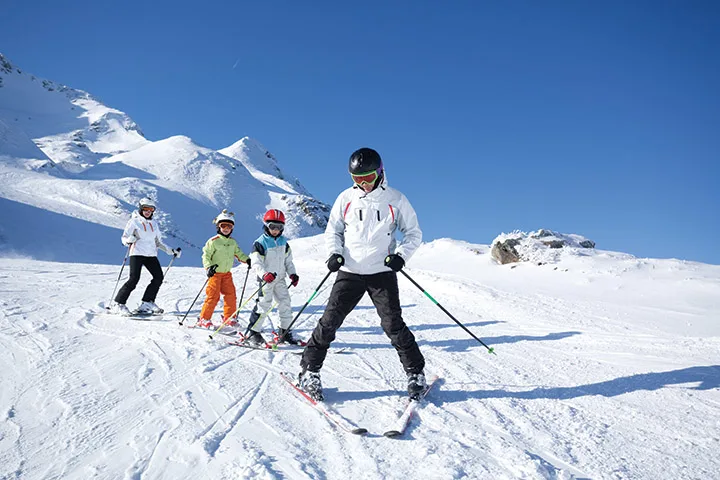Small Things
and the Surprising Benefits of Teaching Others

Written By: Robb Stevens
Every day we each do countless seemingly small things out of routine or habit that have a large impact in our lives. These simple, mundane tasks, movements, or micro-processes produce a predictable result that our brains are conditioned to expect. For example, when is the last time you thought through the process of tying your own shoes? Now try teaching someone HOW to do it, and suddenly, your mind must think about every single part of that process that you take for granted. Subconscious “muscle memory” as it were, ultimately becomes a part of everything we do.
I came to realize this more fully this past winter while skiing with my son. It has been enlightening to realize that it is one thing to know how to ski, but quite another to teach it to someone else! Teaching a skill to others requires a completely different mindset because it forces you to rediscover all the routine steps that you basically take for granted due to thousands of hours of your own practical application.
Going down the hill is one thing, but a skier must be able to turn, or it does not end very well. My attempts to teach my son how to turn have not always made sense to him. What is obvious and second nature to me was new to him and thus difficult at times to fully grasp. On our last ski day, it finally dawned on me what the basic (and for me, subconscious) movement is that leads to a smooth and effortless turn -- it’s all about the big toe! Sure, there is shifting of weight and leaning forward, but the most basic and crucial thing that triggers a turn is inward pressure by one big toe or the other. This was a powerful and revelatory moment for me! Such a small and simple thing produces such a big result. This new insight finally gave me a way to easily explain something in simple enough terms that it could be quickly understood and applied.

In all my years of skiing, I have never stopped to think about this comparatively small action and the huge impact it has until I was tasked with teaching another person. To think that the entire direction of your body while on skis is so drastically influenced by no more than your big toe is really quite remarkable if you think about it.
From this little skiing epiphany, here are my key takeaways:
1) Small and Simple Things: As a basic matter of fact, accomplishing big or great things is often a result of one or even several comparatively small things combined. Think of the impact a small helm on a large ship has on its ability to navigate through water.
2) Understanding vs Misunderstanding: When teaching others, yes, it is critical to help them understand, but it is also important that they don't misunderstand. This can be tricky. When you already know how to do something, the basic steps seem painfully obvious, but to the student, they are far from it. Thus, patience is required while they seek to understand, fully grasp, and ultimately master what is being taught. Most people want to be perceived as a fast learner, so they may quickly tell you that they "get it" when in reality, they may not get it at all. There is an axiom that seems applicable here:
I hear… I forget / I hear and see… I remember / I hear, see and do… I then understand.
The best learning and understanding happens in the application of knowledge. Thus, the best way to teach often provides opportunities for practice and application.
3) The Protégé Effect: Anytime we teach, pretend to teach, or even prepare to teach things to others, it can drastically impact and solidify our own learning of the subject or skill we are teaching. The process of teaching allows us to rediscover things we already knew or discover new insights about things we may not have considered before. With this, our own mastery of information or skills can be greatly enhanced. It stands to reason then that great masters are also great teachers.
The protégé effect improves the learning process by increasing our metacognitive processing. Put more simply, the fastest and best way to learn something is to teach it to someone else. Knowledge, it seems, wants to be free, so teaching really becomes the oxygen of knowledge. When done effectively, the protégé effect strengthens our own learning, knowledge, and understanding while concurrently helping others to learn and succeed. In the process, relationships can be strengthened, confidence and communication skills improved, and leadership abilities enhanced.
It may certainly be true that in life, we should always be learning, but if the protégé effect is as powerful as it appears to be, we should always be teaching too.
• To me, the most obvious and powerful application of the protégé effect is at home teaching my own children. This opportunity exists every day, both directly and indirectly. They are always watching, listening, and taking cues from what I do and say, so even without conscious effort on my part, lessons are being taught.
• At work, there are countless opportunities to teach things to those we lead, our counterparts, new employees, customers, and potential customers. I am much more in-tune with my craft because of the many opportunities during my career I have had to teach it to others.
• There are plenty of other situations in life that are great for teaching others, such as coaching a sports team, teaching a class of some kind, giving a speech, serving in the community, or even social media engagement. Any opportunity to explain concepts or impart knowledge to others can activate the powerful protégé effect.
A candle loses none of its own light by lighting another. In fact, lighting another candle only adds more light! To me, the best part of teaching my son how to ski is that the better he gets, the more we get beyond the teaching phase to the point of just enjoying an activity together. And through it all, I became a better skier!
Prev Article Next Article